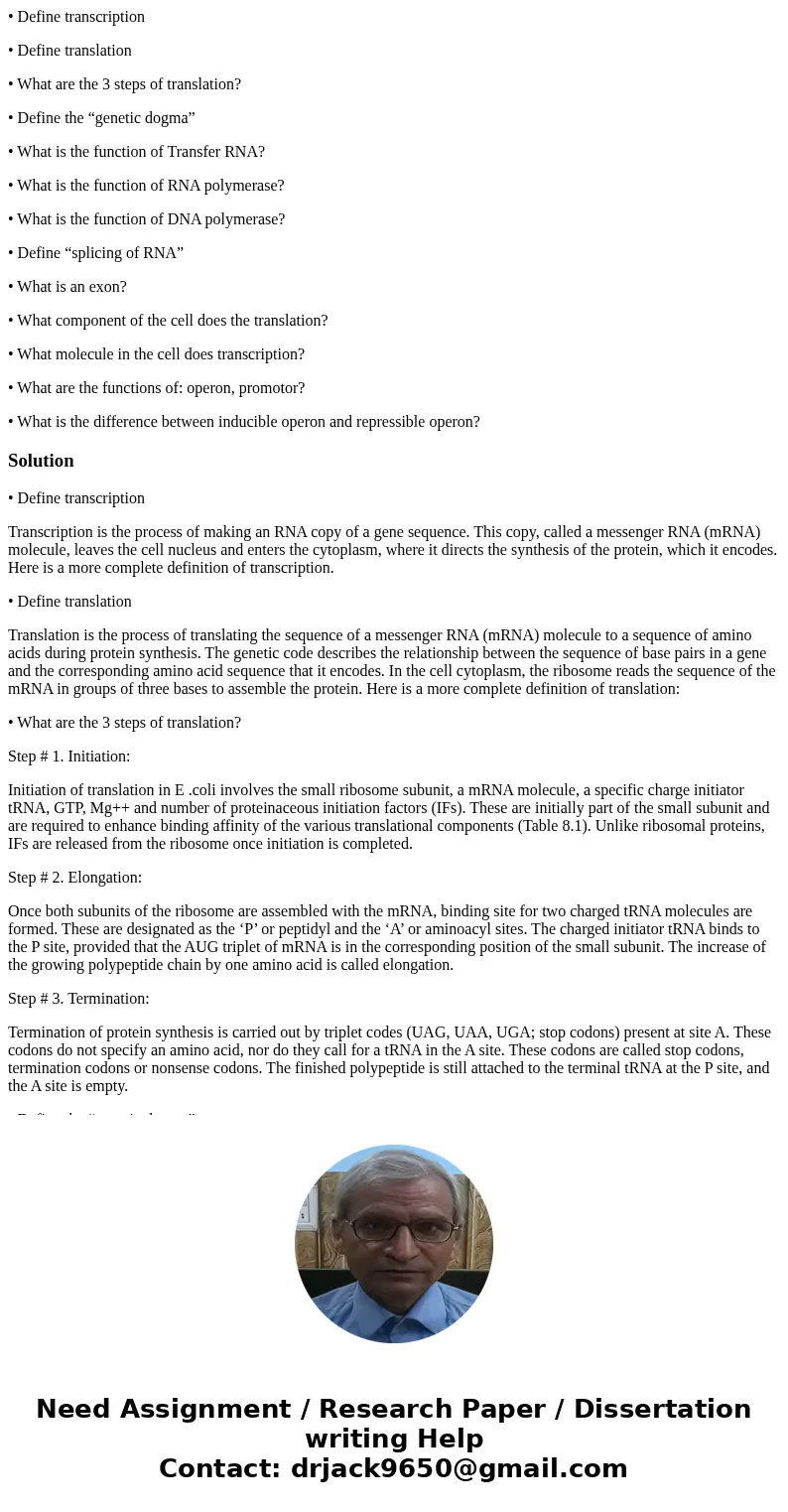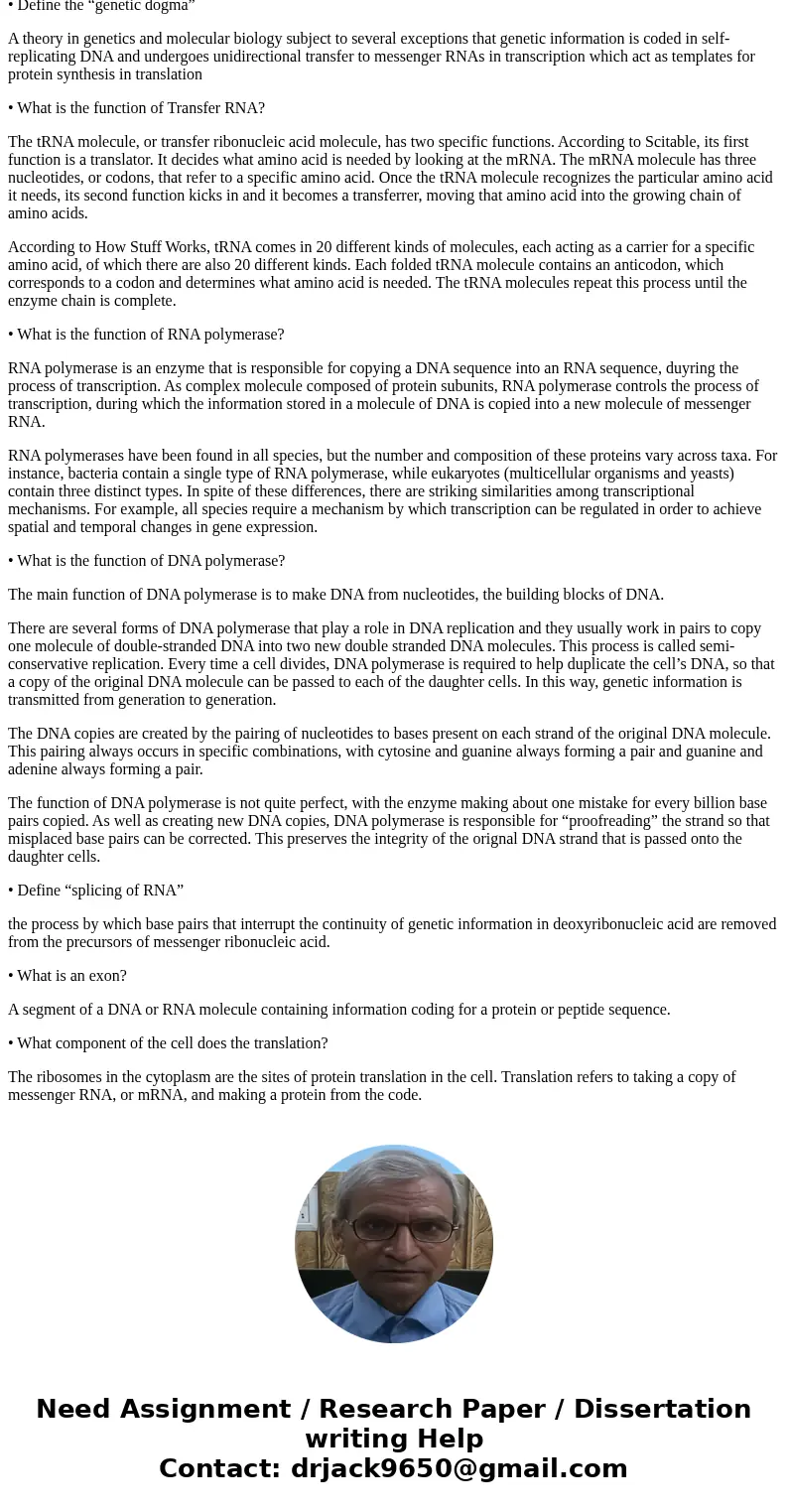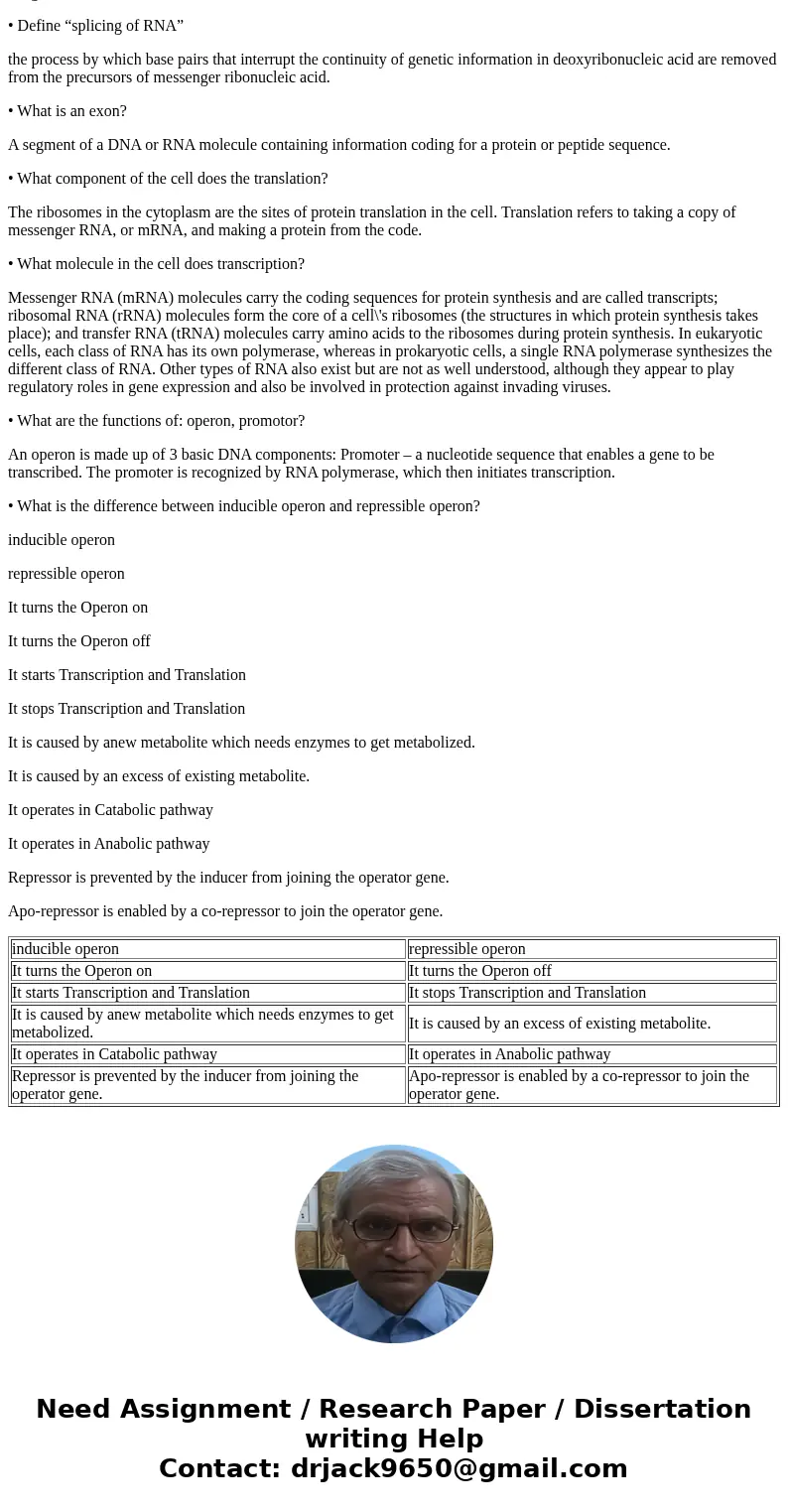Define transcription Define translation What are the 3 st
• Define transcription
• Define translation
• What are the 3 steps of translation?
• Define the “genetic dogma”
• What is the function of Transfer RNA?
• What is the function of RNA polymerase?
• What is the function of DNA polymerase?
• Define “splicing of RNA”
• What is an exon?
• What component of the cell does the translation?
• What molecule in the cell does transcription?
• What are the functions of: operon, promotor?
• What is the difference between inducible operon and repressible operon?
Solution
• Define transcription
Transcription is the process of making an RNA copy of a gene sequence. This copy, called a messenger RNA (mRNA) molecule, leaves the cell nucleus and enters the cytoplasm, where it directs the synthesis of the protein, which it encodes. Here is a more complete definition of transcription.
• Define translation
Translation is the process of translating the sequence of a messenger RNA (mRNA) molecule to a sequence of amino acids during protein synthesis. The genetic code describes the relationship between the sequence of base pairs in a gene and the corresponding amino acid sequence that it encodes. In the cell cytoplasm, the ribosome reads the sequence of the mRNA in groups of three bases to assemble the protein. Here is a more complete definition of translation:
• What are the 3 steps of translation?
Step # 1. Initiation:
Initiation of translation in E .coli involves the small ribosome subunit, a mRNA molecule, a specific charge initiator tRNA, GTP, Mg++ and number of proteinaceous initiation factors (IFs). These are initially part of the small subunit and are required to enhance binding affinity of the various translational components (Table 8.1). Unlike ribosomal proteins, IFs are released from the ribosome once initiation is completed.
Step # 2. Elongation:
Once both subunits of the ribosome are assembled with the mRNA, binding site for two charged tRNA molecules are formed. These are designated as the ‘P’ or peptidyl and the ‘A’ or aminoacyl sites. The charged initiator tRNA binds to the P site, provided that the AUG triplet of mRNA is in the corresponding position of the small subunit. The increase of the growing polypeptide chain by one amino acid is called elongation.
Step # 3. Termination:
Termination of protein synthesis is carried out by triplet codes (UAG, UAA, UGA; stop codons) present at site A. These codons do not specify an amino acid, nor do they call for a tRNA in the A site. These codons are called stop codons, termination codons or nonsense codons. The finished polypeptide is still attached to the terminal tRNA at the P site, and the A site is empty.
• Define the “genetic dogma”
A theory in genetics and molecular biology subject to several exceptions that genetic information is coded in self-replicating DNA and undergoes unidirectional transfer to messenger RNAs in transcription which act as templates for protein synthesis in translation
• What is the function of Transfer RNA?
The tRNA molecule, or transfer ribonucleic acid molecule, has two specific functions. According to Scitable, its first function is a translator. It decides what amino acid is needed by looking at the mRNA. The mRNA molecule has three nucleotides, or codons, that refer to a specific amino acid. Once the tRNA molecule recognizes the particular amino acid it needs, its second function kicks in and it becomes a transferrer, moving that amino acid into the growing chain of amino acids.
According to How Stuff Works, tRNA comes in 20 different kinds of molecules, each acting as a carrier for a specific amino acid, of which there are also 20 different kinds. Each folded tRNA molecule contains an anticodon, which corresponds to a codon and determines what amino acid is needed. The tRNA molecules repeat this process until the enzyme chain is complete.
• What is the function of RNA polymerase?
RNA polymerase is an enzyme that is responsible for copying a DNA sequence into an RNA sequence, duyring the process of transcription. As complex molecule composed of protein subunits, RNA polymerase controls the process of transcription, during which the information stored in a molecule of DNA is copied into a new molecule of messenger RNA.
RNA polymerases have been found in all species, but the number and composition of these proteins vary across taxa. For instance, bacteria contain a single type of RNA polymerase, while eukaryotes (multicellular organisms and yeasts) contain three distinct types. In spite of these differences, there are striking similarities among transcriptional mechanisms. For example, all species require a mechanism by which transcription can be regulated in order to achieve spatial and temporal changes in gene expression.
• What is the function of DNA polymerase?
The main function of DNA polymerase is to make DNA from nucleotides, the building blocks of DNA.
There are several forms of DNA polymerase that play a role in DNA replication and they usually work in pairs to copy one molecule of double-stranded DNA into two new double stranded DNA molecules. This process is called semi-conservative replication. Every time a cell divides, DNA polymerase is required to help duplicate the cell’s DNA, so that a copy of the original DNA molecule can be passed to each of the daughter cells. In this way, genetic information is transmitted from generation to generation.
The DNA copies are created by the pairing of nucleotides to bases present on each strand of the original DNA molecule. This pairing always occurs in specific combinations, with cytosine and guanine always forming a pair and guanine and adenine always forming a pair.
The function of DNA polymerase is not quite perfect, with the enzyme making about one mistake for every billion base pairs copied. As well as creating new DNA copies, DNA polymerase is responsible for “proofreading” the strand so that misplaced base pairs can be corrected. This preserves the integrity of the orignal DNA strand that is passed onto the daughter cells.
• Define “splicing of RNA”
the process by which base pairs that interrupt the continuity of genetic information in deoxyribonucleic acid are removed from the precursors of messenger ribonucleic acid.
• What is an exon?
A segment of a DNA or RNA molecule containing information coding for a protein or peptide sequence.
• What component of the cell does the translation?
The ribosomes in the cytoplasm are the sites of protein translation in the cell. Translation refers to taking a copy of messenger RNA, or mRNA, and making a protein from the code.
• What molecule in the cell does transcription?
Messenger RNA (mRNA) molecules carry the coding sequences for protein synthesis and are called transcripts; ribosomal RNA (rRNA) molecules form the core of a cell\'s ribosomes (the structures in which protein synthesis takes place); and transfer RNA (tRNA) molecules carry amino acids to the ribosomes during protein synthesis. In eukaryotic cells, each class of RNA has its own polymerase, whereas in prokaryotic cells, a single RNA polymerase synthesizes the different class of RNA. Other types of RNA also exist but are not as well understood, although they appear to play regulatory roles in gene expression and also be involved in protection against invading viruses.
• What are the functions of: operon, promotor?
An operon is made up of 3 basic DNA components: Promoter – a nucleotide sequence that enables a gene to be transcribed. The promoter is recognized by RNA polymerase, which then initiates transcription.
• What is the difference between inducible operon and repressible operon?
inducible operon
repressible operon
It turns the Operon on
It turns the Operon off
It starts Transcription and Translation
It stops Transcription and Translation
It is caused by anew metabolite which needs enzymes to get metabolized.
It is caused by an excess of existing metabolite.
It operates in Catabolic pathway
It operates in Anabolic pathway
Repressor is prevented by the inducer from joining the operator gene.
Apo-repressor is enabled by a co-repressor to join the operator gene.
| inducible operon | repressible operon |
| It turns the Operon on | It turns the Operon off |
| It starts Transcription and Translation | It stops Transcription and Translation |
| It is caused by anew metabolite which needs enzymes to get metabolized. | It is caused by an excess of existing metabolite. |
| It operates in Catabolic pathway | It operates in Anabolic pathway |
| Repressor is prevented by the inducer from joining the operator gene. | Apo-repressor is enabled by a co-repressor to join the operator gene. |



 Homework Sourse
Homework Sourse